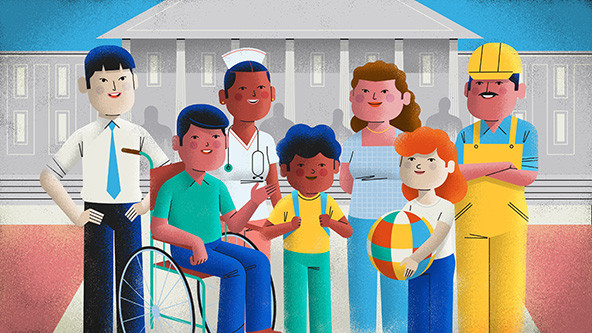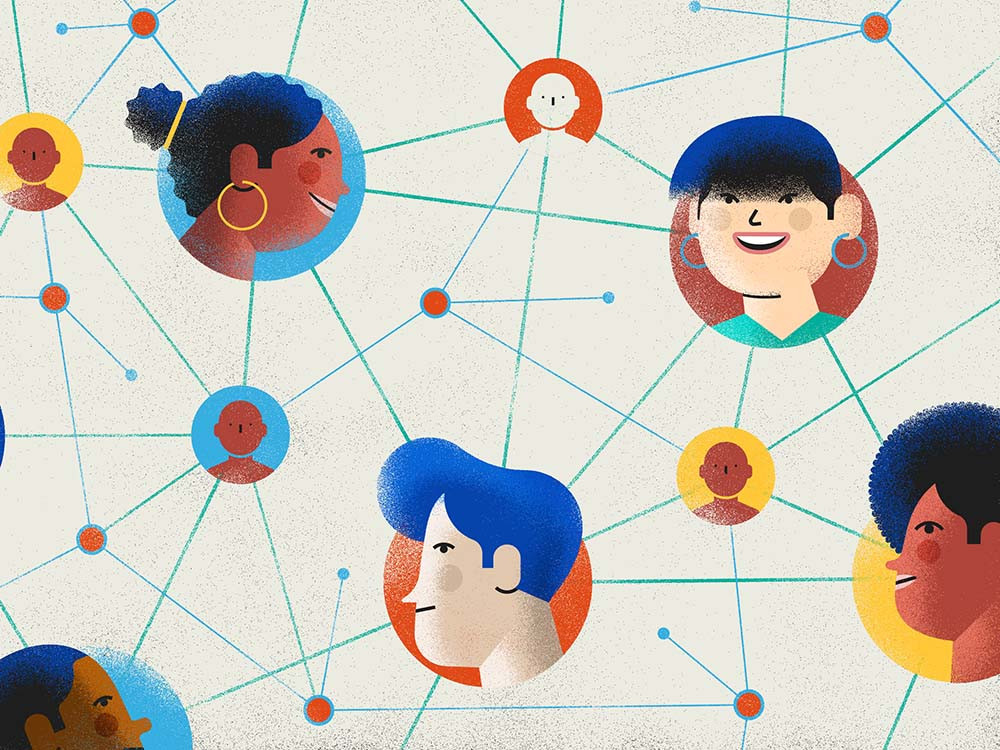 (Illustration by Hugo Herrera)
(Illustration by Hugo Herrera)
In the winter of 2011, the same year as the release of the seminal collective impact article in Stanford Social Innovation Review, I stepped out of my comfort zone to pursue more substantial, population-level impact for children and their families. I left my career with the US Department of Housing and Urban Development in Chicago and joined PolicyLink, a national research and action institute advancing racial and economic equity. I was the inaugural director of the Promise Neighborhoods Institute (PNI) at PolicyLink. Combining the leadership of PolicyLink, the Harlem Children’s Zone (HCZ), and the Center for the Study of Social Policy, PNI worked to build and sustain Promise Neighborhoods. We worked in partnership with the federal Promise Neighborhoods program, itself modeled after HCZ, and envisioned all children and youth growing up in a Promise Neighborhood with access to great schools and strong systems of family and community support that would prepare them to attain an excellent education and successfully transition to college and a career.
When I took the helm of PNI, Geoffrey Canada’s leadership at HCZ and the power and potential embodied in collective impact inspired me. I was obsessed with improving the lives of the millions of children in America living in poverty. For years, local leaders had advocated for new federal investments, and they finally had them in the Promise Neighborhoods program. At PNI, our job was to organize the Promise Neighborhoods grantees into a national community of practice and support their work with technical assistance, evaluation, and fundraising support. We soon realized that without a disciplined approach to moving from talk to action, it would be difficult to accelerate results. Consequently, PNI fostered the collective impact approach to social change, and soon, our network of leaders from more than 40 communities across America adopted the framework.

I spent several years at PNI learning how to improve outcomes for children and their families. My pursuit of results commensurate with the scale of the problems in distressed neighborhoods across America led me to seek and find the most significant leading edge of collective impact: designing a just and fair nation where all can participate, prosper, and reach their full potential. As PNI partnered with leaders from more than 40 rural, tribal, and urban communities, I was impressed by their ability to adopt the collective impact framework and work in a data-informed, results-driven manner. Within the Promise Neighborhoods network, something special was happening. Place-based practitioners were becoming more sophisticated and applying the five conditions of collective impact. Consequently, we witnessed indicators of well-being trending in the right direction.
Because of local leaders’ unprecedented impact, in 2015 Congress permanently incorporated the Promise Neighborhoods program into the Every Student Succeeds Act. While this was a seminal victory because it provided a significant source of revenue for place-based collective impact efforts focused on supporting children and their families from cradle to career, I was dissatisfied with the scale of our impact. The Promise Neighborhoods network was helping thousands of children and achieving exceptional results like reading readiness scores increasing from 19 percent to 55.7 percent in Berea, Kentucky, and 55 percent of elementary students achieving at least one year of reading growth in four months after participating in after school and summer programs in Minneapolis. Despite these local successes and many more, millions more children needed our help. As we disaggregated data to understand better how to accelerate and scale our impact, I had an epiphany. The more we analyzed data, the more I saw how anti-Black racism undercut our results. Housing discrimination increased the number of times students and their families would move and enter and withdraw from school during the year, negatively impacting student mobility rates. Lead poisoning from paint in homes and drinking water impaired cognitive development and prevented students from entering kindergarten ready to learn. Food deserts put children at risk of obesity. Low-wage jobs with no or few benefits increased toxic stress at home and decreased the quality of parenting. The design of our nation was undercutting our results, and civic leaders’ reluctance to address issues of race meant that asking for high returns on investment (ROI) was folly when unaddressed systemic issues undercut ROI.
While leaders in the national Promise Neighborhoods community of practice were not consistently achieving scaled impact, oppressive systems like the ones I describe above were. Members of the community of practice were providing short-term relief to children and their families, and more was needed. To marshal solutions proportionate to the barriers faced by participants in our community of practice, we needed to learn to hold greater complexity in our collective impact work. This meant finding the right mix of solutions—families contributing to their own well-being, nonprofits providing consistently high-quality programs and services, and where appropriate, leaders implementing systems and policy changes.
Too often, local leaders’ mix of solutions were overweighted toward the first two—families contributing to their well-being, and programs and services. Unfortunately, my experience suggests that scale is rarely achieved with these two solutions. Scale is achieved through systems and policy changes. Based on the history of truly scaled impact in the United States, like the creation of the white middle class through policies like free or low-cost college, the GI Bill, and the Federal Housing Administration’s mortgage guarantees, the scaling mechanism is not civil society; it is government. It is unfair to ask nonprofit leaders to achieve population-level impact when corporations and government are allowed to undercut progress through practices that are exclusionary, harm the environment, and create a democracy and economy that to this day leave nearly 100 million people in America economically insecure.
While we must continue launching and sustaining a variety of collective impact efforts that give us the greatest opportunity to realize the promise of equity in our lifetime—just and fair inclusion in a society where all can participate, prosper, and reach their full potential—the collective impact work that will yield transformational results demands we intentionally design a nation for the “all” in the equity definition. This is a moment for leaders committed to achieving collective impact to shake off the husks of complacency, accept our inheritance as stewards of this nation, and compel it to be all that it can be. Equity is the soul of collective impact, and there is new soul work to be done. Our soul work necessitates a continued focus on place-based practice while simultaneously getting to the unfinished business of designing a multiracial democracy where everyone belongs.
Cross-Sector Collaborations for Liberation
When corporate, government, and civil society leaders work in alignment to compel government—especially the federal government—to become anti-racist, we come closer to being a just and fair nation for all. When our nation’s zeitgeist, laws, regulations, customs, and institutions de-center whiteness and center the liberation of Black and Brown people, we will achieve a positive, population-level impact for millions of children and their families. We will finally be governing for all. This is not wishful thinking. At this moment, all three sectors—government, civil society, and corporate America have begun to focus on racial equity and are advancing systems and policy changes that are achieving population impact. Here are a few examples where cross-sector leaders are redesigning a nation to liberate all and oppress none.
- Enacting Reparations | It’s difficult to achieve results at scale when past wrongs have not been righted. Reparations are an example of the type of evolved consciousness needed to move collective impact beyond the realm of charity to liberation. It is wishful thinking to believe that you can design a nation to privilege specific groups for hundreds of years, become alarmed at the subsequent disparity in outcomes between groups, and then think traditional collective impact efforts alone can right these wrongs. Redlining operated at a national scale from the 1930s to 1960s, and vestiges of the practice still occur today. To repair the harm of discriminatory housing policies and practices, the City Council of Evanston, Illinois, approved the implementation of the Reparations Restorative Housing Program. The program provides $25,000 for down payments or home repairs. While this is a small pilot program, it is significant because it has the potential to shift attitudes and perceptions about reparations. Collective impact efforts can replicate this model, place the pursuit of results in historical context, and design reparative practices alongside programmatic ones.
- Ending Cash Bail | Imagine collective impact efforts designed to build wealth in communities, only to have it stripped away by criminal justice systems and the demands of cash bail. This is one of the most pervasive and destructive examples of a design feature of our society that undercuts local charitable efforts and keeps indicators of well-being like the employment rate trending in the wrong direction for too many people. California no longer requires cash bail for those who can’t pay, resulting in millions of people continuing to work, go to school, and care for their families instead of being punished for being poor.
- Raising the Maximum Child Tax Credit | While many of us have worked for years to reduce the poverty rate in our communities, with the stroke of a pen, President Biden lifted 3 million children out of poverty by increasing the child tax credit from $2,000 to $3,000. This is what I mean when I say government, not civil society, is our collective impact scaling apparatus. Promise Neighborhoods and thousands of charitable efforts operating over several years have not achieved the level of impact that the Biden administration accomplished in less than 12 months. Now collective impact leaders must fight to sustain this level of impact.
- Changing Perceptions and Narratives About Race | Leaders in the Black Lives Matter movement stand on the shoulders of those who built our civil rights and equity movements, and they are forcing America to address issues of white supremacy. The movement is growing a multiracial coalition committed to advancing racial equity, and people in America, including the leaders of collective impact, are addressing issues of systemic racism in ways never seen before. Did you ever think you’d see all three sectors—government, civil society, and business—championing racial equity in your lifetime? This is the power of aligned collective consciousness and action. Collective impact efforts can engage in this important racial justice work by examining their structure and programs and designing collaborations that center equity and bring an anti-racist approach to collective impact.
Leaders from all three sectors are manifesting the radical imagination necessary to build an equitable society. This is unprecedented in our nation’s history. Their efforts can’t be one-offs. They need to be scaled and made permanent fixtures in American life. This leading edge of collective impact requires us to change the nature and logic of our governing institutions to become anti-racist. The collective impact approach to social change will serve us well in this moment. It has given our lives and careers purpose. I have grown up in this work, and I am humbled to share my vision for an equitable America. Each generation is invited to perfect our democracy. This means tending to the immediate needs of people in this nation, while simultaneously creating a new multiracial meaning of the nation’s founding documents that result in new ways of governing or governing for all. This nation-building work is the highest form of collective impact. Disciplined, collective action focused on designing a just and fair society for all, thereby ensuring all people in America—particularly those who face the burdens of structural racism—participate in a just society, live in a healthy community of opportunity, and prosper in an equitable economy. Here’s to 10 more years. Stay strong and encouraged.
Support SSIR’s coverage of cross-sector solutions to global challenges.
Help us further the reach of innovative ideas. Donate today.
Read more stories by Michael McAfee.

